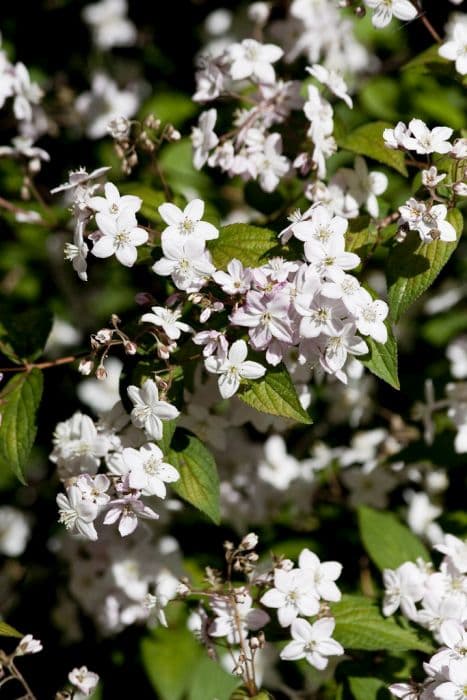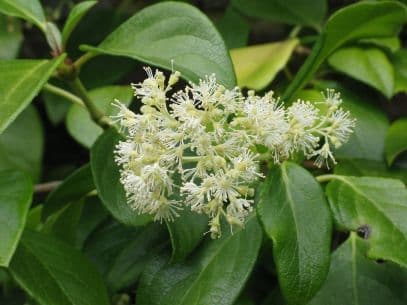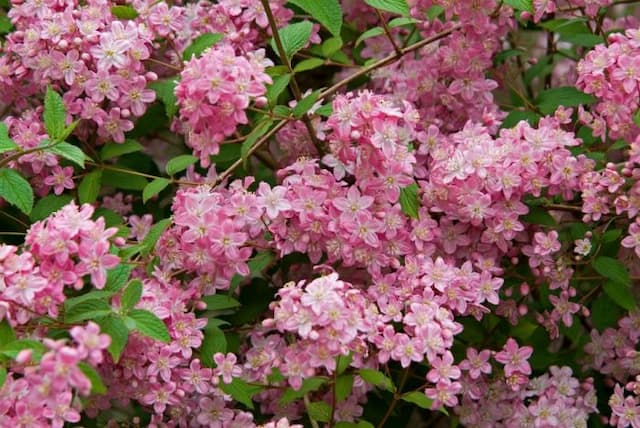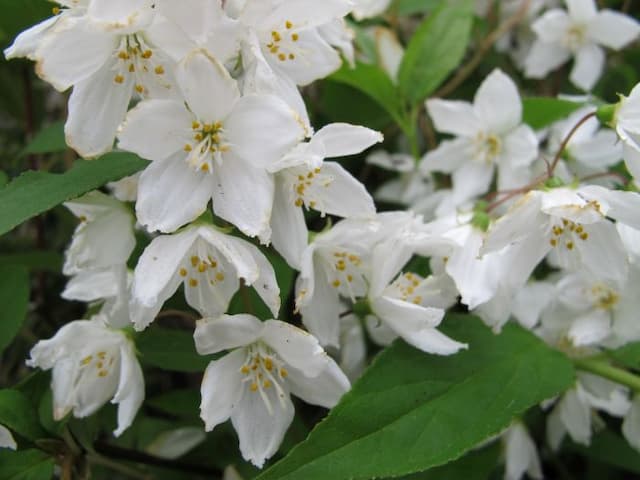Hydrangea Hydrangea macrophylla 'Hobergine' (PBR) (Hovaria Series) (H)

ABOUT
The Hydrangea 'Hobergine', belonging to the Hovaria Series, is a striking garden shrub known for its eye-catching bloom display. The flowers emerge as large, rounded clusters, often referred to as mopheads, that bring a showy element to the landscape. These blossoms exhibit a unique color palette reminiscent of aubergines, with shades ranging from deep purples to rich blues, often influenced by the soil pH. In some cases, the petals may present with a creamy, antique green tint at the edges, enhancing their vintage appeal. The leaves of 'Hobergine' are equally handsome, boasting a deep green color and a glossy finish that serves as a perfect backdrop to the vividly hued flowers. They have a broad, ovate shape and a pronounced texture, with a serrated edge that further contributes to the ornamental quality of the plant. As the seasons change, so can the color nuances of the blossoms, offering a dynamic display that evolves throughout the blooming period. These captivating flower heads are supported by sturdy stems, which stand upright amidst the lush foliage. 'Hobergine' is praised not only for its floral pageantry but also for its ability to attract pollinators, making it a beneficial addition to any garden designed to encourage biodiversity.
About this plant
 Names
NamesFamily
Hydrangeaceae.
Synonyms
Bigleaf Hydrangea, French Hydrangea, Lacecap Hydrangea, Mophead Hydrangea, Penny Mac, Hortensia.
Common names
Hydrangea macrophylla 'Hobergine'
 Toxicity
ToxicityTo humans
The most common common name for Hydrangea macrophylla 'Hobergine' is simply hydrangea. Hydrangeas are considered to have a low level of toxicity to humans. Ingesting any part of the plant can cause gastrointestinal upset, with symptoms such as nausea, vomiting, and diarrhea. The plant contains compounds like hydrangin, which is a cyanogenic glycoside and can potentially release cyanide in the body. However, significant poisoning from hydrangeas is rare in humans, as large quantities of the plant material would need to be consumed to cause severe toxicity.
To pets
Hydrangea, the most common name for Hydrangea macrophylla 'Hobergine', is toxic to pets, including dogs, cats, and horses. The toxic principle in the plant is the presence of cyanogenic glycosides, which can release cyanide when chewed or digested. If a pet ingests parts of a hydrangea plant, it may experience symptoms such as vomiting, diarrhea, and lethargy. In severe cases, ingestion might also lead to depression, anorexia, and increased heart rate. While serious cases are uncommon, it is advisable to keep pets away from hydrangeas and seek veterinary attention if you suspect your pet has ingested any part of the plant.
 Characteristics
CharacteristicsLife cycle
Perennials
Foliage type
Deciduous
Color of leaves
Green
Flower color
Varies
Height
4-5 feet (1.2-1.5 meters)
Spread
4-5 feet (1.2-1.5 meters)
Plant type
Shrub
Hardiness zones
5
Native area
Japan
Benefits
 General Benefits
General Benefits- Ornamental Appeal: The Hydrangea macrophylla 'Hobergine' features large, vibrant blossoms that add visual interest to any garden or landscape.
- Diverse Color Range: Depending on soil pH, the flowers can range in color from blue to pink, offering a variety of looks in a single type of plant.
- Seasonal Interest: With a long blooming season from early summer to fall, it provides extended decorative value throughout the growing season.
- Shade Tolerance: This hydrangea is capable of thriving in partial shade, making it a versatile choice for different garden conditions.
- Attracts Pollinators: The flowers attract bees and butterflies, which are beneficial for pollinating gardens and local ecosystems.
- Works as a Cut Flower: The lush blossoms make excellent cut flowers for indoor arrangements, lasting well in vases.
- Enhances Property Value: A well-kept garden featuring attractive plants like Hydrangea macrophylla 'Hobergine' can increase overall property appeal and value.
 Medical Properties
Medical PropertiesThis plant is not used for medical purposes.
 Air-purifying Qualities
Air-purifying QualitiesThis plant is not specifically known for air purifying qualities.
 Other Uses
Other Uses- Hydrangeas can be used as natural pH indicators. The color of their blooms can change based on the acidity or alkalinity of the soil, providing a visual indicator of soil pH.
- The dried flowers of Hydrangeas can be used to create lasting floral arrangements. These dried blooms retain their shape and color well when preserved.
- Hydrangea leaves can be used for creating botanical prints, where the shape and texture of the leaves are transferred onto paper or fabric.
- The abundant foliage of Hydrangeas offers a dense cover that provides privacy in gardens when planted as hedges or in mass plantings.
- Hydrangea flowers can be used as a natural dye for fabrics, yielding colors varying from pale green to soft pink or blue hues depending on the soil condition.
- These plants can be utilized in educational settings to demonstrate plant propagation techniques, as they can be relatively easily propagated from cuttings.
- In garden design, Hydrangeas can be used to create a focal point due to their large, showy flower heads, particularly in cottage or country garden styles.
- Blossoms from the Hydrangea can be used in crafting, such as making flower crowns or for embellishing hand-made greeting cards or scrapbook pages.
- Hydrangea wood is sometimes carved into small pieces of art or jewelry, although it's not a common wood for these purposes due to it being fairly soft.
- The large leaves of the Hydrangea can be used as a natural wrapping material for small packages or as placemats in eco-friendly table settings.
Interesting Facts
 Feng Shui
Feng ShuiThe Hydrangea is not used in Feng Shui practice.
 Zodiac Sign Compitability
Zodiac Sign CompitabilityThe Hydrangea is not used in astrology practice.
 Plant Symbolism
Plant Symbolism- Heartfelt Emotions: Hydrangeas often symbolize deep understanding and genuine emotion due to their lush, round clusters of flowers that could be seen as a symbol of the fullness of the heart.
- Gratitude: With its abundant flowers, the hydrangea can be given as a gesture of thanks or gratitude towards another person.
- Apology: In some contexts, hydrangeas can be associated with apologies, perhaps because of the variability of their color which can fade, symbolizing an error or regret over a past action.
- Vanity: In certain cultures, the hydrangea carries a negative connotation of vanity or boastfulness, which might have originated from the showy nature of its large flower heads.
- Abundance: The lavish and voluminous blooms of the hydrangea represent abundance and prosperity.
- Perseverance: The hydrangea's ability to thrive and bloom in a range of conditions can symbolize persistence and determination to overcome obstacles.
 Water
WaterBigleaf hydrangeas prefer consistently moist soil, so it's important to water them regularly. Depending on the climate, this could mean watering once or twice a week, with each plant needing about 1 gallon of water each time. During hot spells or drought, water the plants deeply to encourage root growth. It's best to water early in the morning to reduce evaporation and discourage leaf diseases. Avoid overhead watering to prevent wetting the foliage; instead, water at the base of the plant to keep the roots well-hydrated.
 Light
LightBigleaf hydrangeas thrive in morning sun with afternoon shade, especially in hotter climates. They can handle full sun in cooler regions provided they get enough moisture. The ideal spot for planting them would be an area that receives filtered sunlight or dappled shade throughout the day. Avoid deep shade, as this can reduce blooming.
 Temperature
TemperatureBigleaf hydrangeas perform best in an environment where temperatures range from 65 to 75 degrees Fahrenheit. They can tolerate temperatures as low as 5 degrees Fahrenheit in winter, making them hardy to USDA zones 6 to 9. Avoid planting in areas where temperatures may exceed 80 degrees Fahrenheit for prolonged periods, as excessive heat may stress the plants or impact flowering.
 Pruning
PruningBigleaf hydrangeas should be pruned to remove dead wood and to shape the plant, generally after the blooms fade in late summer or fall. They bloom on old wood, so avoid extensive pruning in spring or early summer which can inadvertently remove flower buds. Pruning immediately after flowering allows the plant time to develop the next season's buds.
 Cleaning
CleaningAs needed
 Soil
SoilThe best soil mix for hydrangeas, like the Hydrangea macrophylla commonly known, should be rich, moist, and well-draining, with organic matter such as compost or peat moss mixed in. Hydrangeas prefer a soil pH that allows for optimal uptake of nutrients, typically between 5.5 and 6.5; however, for blue flowers, a more acidic soil with a pH closer to 5.0 is preferred, and for pink flowers, a more alkaline soil with a pH around 6.5 to 7.0 is ideal.
 Repotting
RepottingHydrangeas typically need to be repotted every 2-3 years to ensure they have enough room to grow and adequate nutrients. The best time to repot these plants is during the dormant season, in late winter or early spring before new growth begins.
 Humidity & Misting
Humidity & MistingHydrangeas thrive in environments with moderate to high humidity levels but can tolerate lower humidity if necessary. Aim for a humidity level around 50-60% for the best growth and flower production. Avoid placing them in excessively dry conditions, which can cause stress and affect blooming.
 Suitable locations
Suitable locationsIndoor
Place in bright, indirect light and maintain moist soil.
Outdoor
Plant in partial shade; water regularly.
Hardiness zone
6-9 USDA
 Life cycle
Life cycleThe Hydrangea macrophylla 'Hobergine' (PBR) (Hovaria Series), commonly known as Hydrangea, begins its life cycle as a dormant, bare-root plant or from cuttings which, when planted in soil, develop roots and shoots. As spring arrives, the hydrangea breaks dormancy with new growth emerging from the buds; it develops lush green foliage and, given proper care, will enter a rapid vegetative growth phase. During the summer months, the plant brings forth large, colorful flowers that can range in color from pink to blue, depending on the soil's pH level. After blooming, the hydrangea enters a period of senescence in late summer or fall where the flowers fade and leaves begin to yellow. The plant then prepares for dormancy as temperatures drop; in winter, above-ground growth dies back, and the plant conserves energy in its roots. In the following spring, the cycle begins anew with the hydrangea reemerging and working towards the next season's bloom.
 Propogation
PropogationPropogation time
Spring to Summer
The most popular method of propagating the Hydrangea macrophylla, commonly known as the bigleaf hydrangea, is through stem cuttings. This technique is usually performed in late spring to early summer as the plant produces new, lush growth. Softwood cuttings, which are the tender new shoots, are cut with a sharp, clean pair of pruners. Cuttings should be about 5 inches long and include several sets of leaves. The lower sets of leaves are removed, and the cut end is typically dipped in rooting hormone powder before being planted in a moist potting mix. These cuttings are then placed in a warm, well-lit area but out of direct sunlight, and kept consistently moist. It often takes several weeks for the cuttings to root, after which they can be potted on or eventually planted out into the garden.




![Hydrangea [Pink Annabelle] ('Ncha1')](/_next/image?url=https%3A%2F%2Fplants-admin.emdemapps.com%2Fimages%2Fplants%2F%2Fimages%2F604b576c63619.png&w=640&q=75)




